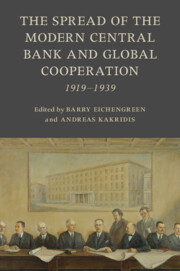Refine search
Actions for selected content:
10 results
Nuevas estimaciones históricas de la incidencia de la pobreza urbana de ingresos en Chile (1940-1992): New Historical Estimations of the Incidence of Urban Income Poverty in Chile (1940-1992)
-
- Journal:
- Revista de Historia Economica - Journal of Iberian and Latin American Economic History / Volume 43 / Issue 1 / March 2025
- Published online by Cambridge University Press:
- 13 May 2025, pp. 107-128
- Print publication:
- March 2025
-
- Article
-
- You have access
- Open access
- HTML
- Export citation
1 - Interwar Central Banks
- from Part I - General
-
-
- Book:
- The Spread of the Modern Central Bank and Global Cooperation
- Published online:
- 02 November 2023
- Print publication:
- 16 November 2023, pp 3-39
-
- Chapter
- Export citation

The Spread of the Modern Central Bank and Global Cooperation
- 1919–1939
-
- Published online:
- 02 November 2023
- Print publication:
- 16 November 2023
11 - Secular Stagnation and Functional Finance
-
- Book:
- Structuralist and Behavioral Macroeconomics
- Published online:
- 10 November 2023
- Print publication:
- 21 September 2023, pp 299-335
-
- Chapter
- Export citation
LABOR MARKET DYNAMICS UNDER TECHNOLOGY SHOCKS: THE ROLE OF SUBSISTENCE CONSUMPTION
-
- Journal:
- Macroeconomic Dynamics / Volume 26 / Issue 8 / December 2022
- Published online by Cambridge University Press:
- 11 June 2021, pp. 1965-1993
-
- Article
- Export citation
Knight, financial institutions, and entrepreneurship in developing economies
-
- Journal:
- Journal of Institutional Economics / Volume 17 / Issue 6 / December 2021
- Published online by Cambridge University Press:
- 14 May 2021, pp. 989-1003
-
- Article
-
- You have access
- Open access
- HTML
- Export citation
Are early palliative procedures providing an adequate long-term benefit in young cyanotic infants from developing countries, despite advances in surgery and interventions?
-
- Journal:
- Cardiology in the Young / Volume 31 / Issue 3 / March 2021
- Published online by Cambridge University Press:
- 16 November 2020, pp. 358-370
-
- Article
- Export citation
7 - Navigating the CSR Discourse from a Developing Country’s Perspective: a Shift to Human Capital Development?
- from Part I - Institutions, CSR Conceptualizations and Sustainable Development
-
-
- Book:
- Corporate Social Responsibility in Developing and Emerging Markets
- Published online:
- 18 December 2019
- Print publication:
- 19 December 2019, pp 119-130
-
- Chapter
- Export citation
10 - Nigeria’s Informal Economy, Social Responsibility and Sustainable Development
- from Part II - CSR and Sustainable Development Cross-Country Studies
-
-
- Book:
- Corporate Social Responsibility in Developing and Emerging Markets
- Published online:
- 18 December 2019
- Print publication:
- 19 December 2019, pp 191-205
-
- Chapter
- Export citation
Inverting Donaldson’s Framework: A Managerial Approach To International Conflicts Of Cultural And Economic Norms
-
- Journal:
- Business Ethics Quarterly / Volume 25 / Issue 4 / October 2015
- Published online by Cambridge University Press:
- 27 October 2015, pp. 535-558
- Print publication:
- October 2015
-
- Article
- Export citation
